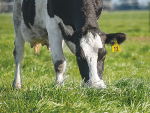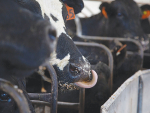This month we’ll focus on how to assist in a calving, give some tips to increase your chance of success and advice on when to seek veterinary help.
How to intervene
The cow or heifer should be adequately restrained in a crush or tied with a halter to a suitably fixed object. Hygiene is important and all equipment (including arms) must be thoroughly cleaned to avoid contamination of the reproductive tract.
You will need:
- Two clean buckets of warm water
- Jug
- Mild liquid soap
- Disinfectant (e.g. chlorhexidine)
- Paper towels
- Obstetrical lubricant
- Calving chains of variable lengths
- Calving rope/head snare
- Calving handles
- Obstetric gloves
- Calving jack or pulley (experienced personnel only)
- Resuscitator (optional)
- 7% iodine for calf navel
It is helpful to have all these things readily accessible in a designated box or bucket.
Place the calving chains and head snare in one of the buckets with some disinfectant. Use the second bucket and mild liquid soap to thoroughly wash the anus and vulva of the cow (the jug helps here), ensuring all excess soap is rinsed off.
Use the remaining soapy water to wash your hands and arms and dry with paper towel. Wearing obstetric gloves with sufficient lubricant, insert your hand through the vulva and into the vagina of the cow.
Determining the position of the foetus
Calves can present in many different positions (see last month’s article). Sometimes it can be difficult to determine the position of the foetus and therefore what needs to be done to correct it.
Start by assessing the size of the calf relative to the birth canal. A vaginal delivery should be possible when:
With the calf coming forward you can fit your hand entirely over the calf’s head in the pelvis of the dam or if you can extend the front legs so that both fetlocks are a hand’s breadth past the vulva of the cow when traction using only handles (and humans!) is applied.
With the calf coming backward you can fit your hand entirely over the calf’s hips in the pelvis of the dam or if you can see the hocks of the calf at the level of the vulva when traction is applied using only handles (and humans).
Front leg vs back leg?
This is a common error and can result in excessive traction on two ‘back legs’ when in fact they are two front legs and the head is flexed backwards. The calf will never be delivered this way.
A helpful tip is to count the number of bendable joints between the elbow (or hock) and the hoof of the calf.
There are two bendable joints between the elbow and the hoof (the knee and the fetlock) whereas there is only one bendable joint (the fetlock) between the hock and hoof.
Calving chains
Chains are generally used around the limbs of calves to allow traction using a calving jack or pulley. An advantage of chains over ropes is that they are easy to remove after traction has ceased and they are easily cleaned.
It is essential that they are placed correctly to avoid damage to the legs of the calf. Chains should be placed in a double half hitch, with the hitch aligned along the front of the legs.
One hitch should be above the first joint (fetlock) counting from the hoof and the other should be placed below this same joint. This helps prevent fractures of the limbs when traction is applied.
Head snares
Head snares are usually made of rope, although plastic or wire loops are also used. Rope head snares consist of a thin piece of rope with a loop at one or both ends. They are often essential as they allow traction on the head independently of the legs. Careful placement is necessary to avoid damaging the calf.
The loop of the snare should be positioned over the top of the calf’s head, behind both ears and the hitch of the snare should be placed in the calf’s mouth and pulled until the loop tightens.
Snares should never be positioned around the lower jaw as this will increase the risk of fracture.
Traction
Traction can be performed manually, using handles attached to calving chains and the head snare, or mechanically using a calving pulley or jack.
Serious injury can result if calving pulleys or jacks are used inappropriately and advice should be sought from those experienced in this procedure prior to attempting it yourself.
Other forms of mechanical traction which are not intended for this purpose should not be used to deliver calves as this can result in serious damage or death to the calf and/or cow.
In a normally presented calf, traction should be applied on alternate front legs to ‘crawl the calf’ out through the pelvis. When both front legs are fully out of the vulva, traction can be applied on both legs at the same time. Aim to apply traction simultaneously with the dam straining.
Once the shoulders of the calf have passed through the vulva, rotate the calf 90 degrees to help the hips (which are the widest part of the calf) pass through the pelvis more easily. This will help prevent ‘hip lock’.

When to seek help
Ultimately, if an abnormal position is found, experience and judgement will decide on whether professional help is required to deliver the calf. Guidelines for when to call for veterinary assistance include:
- If you have observed the cow or heifer to have a prolonged calving (stage 1 or stage 2 labour) and you are unable to provide assistance yourself.
- If you have observed the cow or heifer to have a prolonged stage 1 but you cannot find either the legs or head on examination.
- If you cannot advance your arm into the birth canal.
- If there has been no progression after 20 minutes of you trying to deliver the calf.
- If there is a fetid smell or obviously dead calf.
- If there is a disproportionately large calf to the size of the dam and it feels like there is ‘no room’.
- If the health of the cow or heifer is a concern.
- If the cow or heifer is down and unable to stand.
• Gemma Chuck is a dairy vet working at The Vet Group in south west Victoria, Australia. She has a special interest in calf rearing and is currently undertaking her PhD in this subject at the University of Melbourne.


















